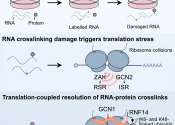Scientists discover a new stress response pathway for repairing RNA-protein crosslinks caused by toxic aldehydes
The research team of Professor Petra Beli and their collaborators have discovered that aldehydes, a type of toxic chemical produced by the body after drinking alcohol, damage cells by creating chemical crosslinks between ...









